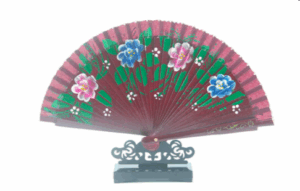目录
ToggleThe chinese fans history stretches back over 3,000 years, encompassing practical use, artistic expression, and social symbolism. Fans in ancient China were not merely tools for cooling; they represented status, taste, and cultural identity.
From the Han Dynasty through the Tang , Song , and Ming dynasties, fans evolved in shape, material, and meaning, reflecting China’s rich heritage. Understanding the chinese fans history provides insight into the intersection of art, society, and everyday life, highlighting how objects as simple as a fan could carry deep cultural significance.
1. Chinese Fans History and Symbolism
- Origins and Early Uses
The earliest fans were crafted from feathers, bamboo, and silk. During the Han Dynasty, fans symbolized refinement and scholarly pursuits. Government officials often carried silk fans, while jade or gold-accented fans were reserved for nobility. By the Tang Dynasty, folding fans became increasingly popular, spreading both in court culture and among common people.
During the Song Dynasty, fans were frequently decorated with paintings or calligraphy, serving as canvases for artistic and literary expression. This evolution illustrates how the chinese fans history intertwines with social hierarchy, artistic trends, and daily life.
- Symbolic Meanings
Fans often carry deep symbolic meanings. Designs such as peonies represent wealth and honor, while plum blossoms convey perseverance and beauty. Fans decorated with these motifs were used during festivals or ceremonial events to convey respect, goodwill, and positive intentions.
The decorative patterns were not purely aesthetic—they communicated social and cultural values, reflecting centuries of the chinese fans history.
2. Artistic Expression and Craftsmanship
- Materials and Techniques
Throughout history, craftsmanship has been central to Chinese fan-making. Traditional fans used bamboo for ribs, high-quality wood for frames, and silk or paper for surfaces. Artists painted flowers, landscapes, and calligraphy, turning functional items into miniature works of art.
Fans were often lightweight, ranging from 50 to 120 grams, with rib lengths between 20 and 25 centimeters, allowing ease of use while maintaining structural stability.
The detailed handwork, precision in rib construction, and careful application of pigments highlight the technical sophistication evident in the chinese fans history.
- Cultural and Seasonal Symbolism
Fans are often associated with seasons or specific cultural practices. Peonies symbolize spring and prosperity, roses symbolize love and beauty, and other motifs carry regional or festival-related meanings.
Fans were frequently used during rituals, celebrations, and as gifts, illustrating how symbolism was integrated with practical and social functions throughout the chinese fans history.
3. Functions Beyond Cooling
- Social and Ceremonial Roles
Fans historically played significant roles in social life and ceremonies. Scholars used them during poetry readings, performers incorporated them into traditional dances, and officials carried them as part of formal attire.
Historical records from the Song Dynasty indicate that fans were exchanged as gifts to convey respect, friendship, or congratulations, demonstrating their cultural and social significance within the chinese fans history.
- Fans as Symbols of Artistic and Cultural Appreciation
Beyond their practical function, fans have long been cherished as objects of artistic and cultural experience, reflecting the rich chinese fans history. The intricate designs, hand-painted motifs, and symbolic imagery on fans offered viewers a way to engage with traditional aesthetics and cultural narratives.
Appreciating a fan’s artwork allowed people to connect with seasonal themes, historical stories, and philosophical ideas, making fans not only beautiful objects but also tangible links to China’s artistic heritage.
4. Modern Interpretation of Chinese Fans
(1)Continuity of Artistic Heritage
The chinese fans history continues to inspire contemporary design and cultural appreciation. Modern hand-painted fans retain traditional techniques while appealing to present-day aesthetics.
They exemplify how centuries-old craftsmanship remains relevant in a modern context, highlighting both cultural continuity and evolving artistic expression.
(2)Representative Examples of Traditional Fans
Two notable examples demonstrate traditional Chinese fan craftsmanship:
- Chinese Peony Bouquet Print Hand Fan– Crafted with lightweight wooden ribs and a non-woven fabric surface, this fan displays clusters of peony prints in soft colors against a deep purple base. The design reflects elegance and conveys symbolic meanings of prosperity and honor. Its rib length is approximately 22 cm, with an overall diameter of 38 cm, and it weighs about 70 grams, balancing durability and lightness.

- Red Brown Chinese Hand Painted Multicolor Rosa Multiflora Fan– From rib construction to multicolor hand-painted designs, this fan exemplifies meticulous craftsmanship. The rib length is around 23 cm, and the fan spans 40 cm when open, weighing approximately 80 grams. Each fan is unique, demonstrating the integration of functional design and artistic expression, preserving traditional techniques central to the chinese fans history.

5. Global Cultural Influence
Chinese fans have influenced decorative arts, fashion, and interior design worldwide. Their lightweight structure, balanced proportions, and symbolic motifs continue to inspire artists and designers.
The global appreciation for fan art demonstrates the enduring relevance of the chinese fans history, illustrating how traditional crafts can adapt and endure while maintaining cultural significance.
6. Conclusion
The chinese fans history represents more than functional tools—it embodies centuries of artistic expression, cultural symbolism, and social tradition. Fans have served as status symbols, artistic canvases, and ceremonial objects, reflecting China’s rich heritage.
By understanding their historical and cultural context, we can appreciate the skill, creativity, and meaning embedded in these objects, connecting contemporary audiences with centuries of tradition and craftsmanship.
0
